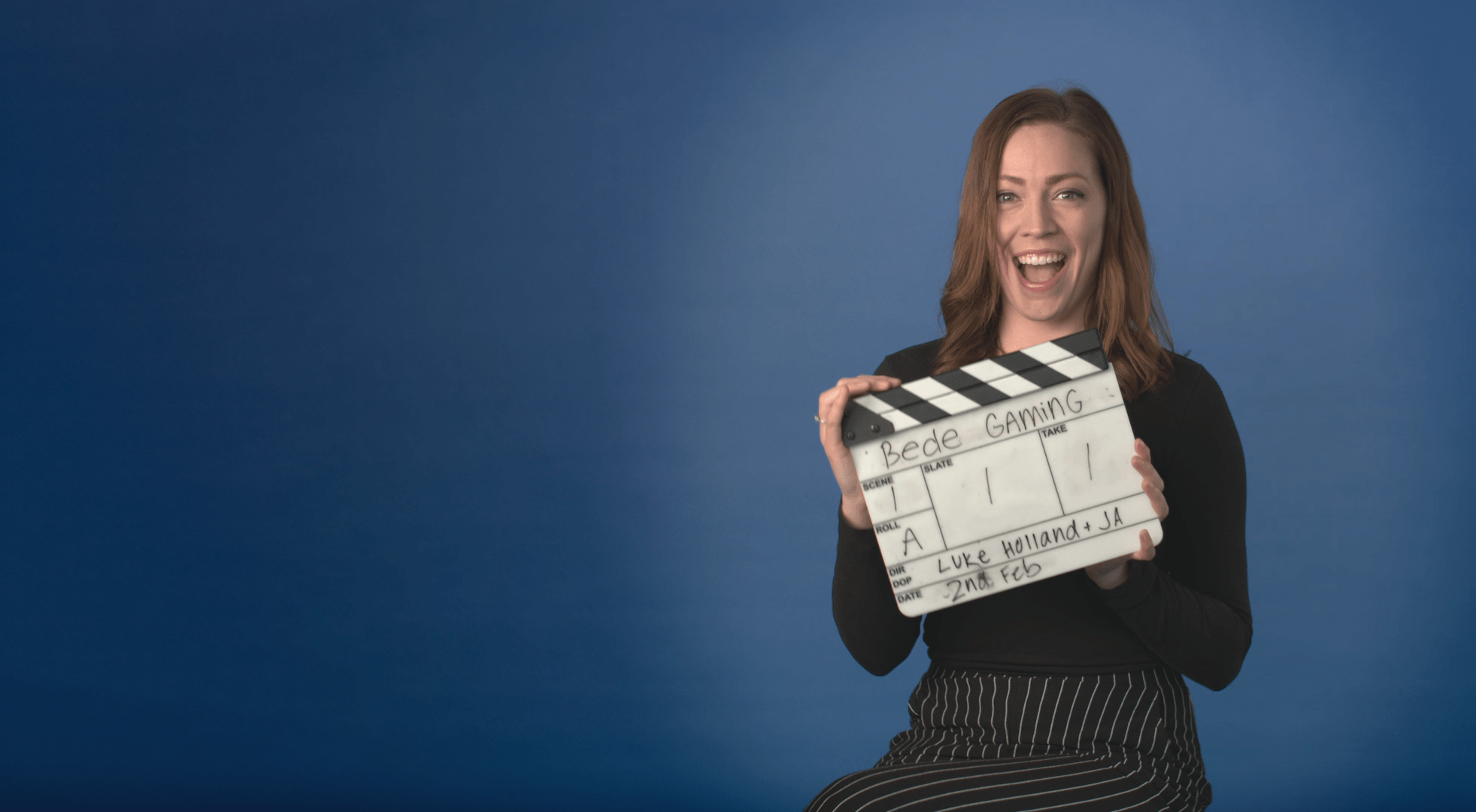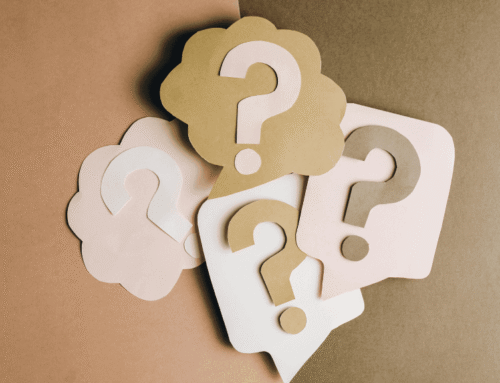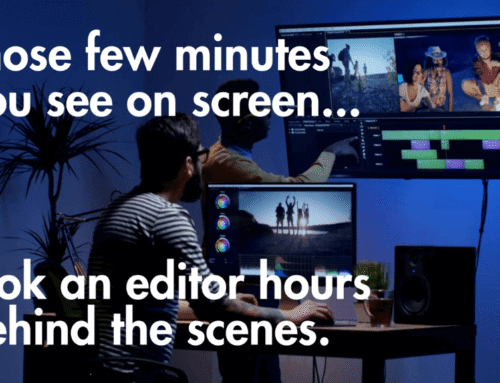If you’ve ever seen a behind-the-scenes shot of a film set, then you’ve definitely seen it. A board with a hinged top clacked shut before the director yells “Action!”. That’s the clapperboard, and it’s not just there to make us look like we know what we’re doing. It’s one of the most useful tools in video production, from cinema releases, to branded content and social ads.
So what exactly does it do? Why do we write things like Scene 3, Take 7 on it? (Or sometimes “Note to editor: Sorry that this we need you to watch 32 takes of this”) And what does all of that writing actually mean? Let’s take a peep:
So, What is a Clapperboard?
A clapperboard – sometimes called a slate, is the board that appears on screen at the start of a take, snapped shut to create that satisfying clack. It’s made up of two parts:
- The slate (or the board as most people call it now) – the board where key details are written (often in child-like scrawl if Luke’s writing it)
- The sticks – the hinged part that makes the snapping sound
It’s main job is to help the editor sync sound and video later on. It also acts as a quick reference point when you’re faced with hundreds of clips during post-production.
Why Do We Call It a Slate?
The term slate dates back to early cinema when crews used chalkboards to note scene details (BFI). Even though we’ve ditched chalk for non-permanent markers (…we’ve ALL use permanent marker on a board at least once), the name stuck. On set, you’ll still hear people say things like “mark the slate” or “what’s on the board?” but on ours, typically you’ll hear someone shout “where’s the bloody pen for the board gone?”.
The Sound
That loud clap isn’t just for dramatic effect. Cameras and sound recorders often run separately for better quality. To align them in post, editors need a single frame and a sharp sound that match up perfectly. The clapperboard provides both:
- Visual cue – the sticks closing
- Audio cue – the snap of the clap
Without it, syncing hundreds of takes would be an absolute nightmare. We’d know because we’ve done it in the past and I don’t think we could do that to poor Dominic (Turps Film’s lead editor) again.


A Quick History of the Clapperboard
Clapperboards started as simple chalk slates. When fancy-pants films with SOUND arrived in the late 1920s, syncing picture and sound became tricky. A solution was to attach a hinged strip of wood that made a loud clap when it shut. That gave editors a clear sync point. Who knew clapperboards had been around that long?
Today, most clapperboards are dry-wipe. You can get digital ones with LED timecode but, at around £1,000 a pop…we’ll stick with our bit of plastic and wood thanks.
How to Read a Clapperboard
What’s Written on a Clapperboard and Why
Here’s what you’ll usually see:
- Production name – So nobody mixes up footage from different shoots. (Very easily done, especially with product shoots)
- Director & DoP – Helpful when multiple crews are filming.
- Scene – The specific part of the script or storyboard being shot.
- Slate / Roll – A unique ID for each setup (originally referred to film rolls).
- Take – How many attempts at the same shot. (If you’re really smart, you’ll have someone on set annotating which takes were good, this can save a load of time in the edit. “Excellent delivery on take 3” “Slightly better delivery on take 63, use one of these two takes then fire the director for doing 63 takes.”
- Date – Vital on multi-day shoots.
- FPS (Frames Per Second) – To ensure playback speed matches the plan.
- Extra notes like MOS – There’s an old rumour that this was a German director working on a film doing shots without sound … or, “Mit Out Sound”. A fun story but there are loads of theories. We like “mute on screen” but essentially it just means no audio recorded for that take.
These details save huge amounts of time in post-production – and that means cost savings too.


Clapperboard Jargon You’ll Hear on Set
Here are a few phrases you might overhear:
- Second sticks – If the first clap wasn’t clear, the clapper loader or AC (assistant camera) does another.
- Tail slate – If you missed the slate at the start, you do it at the end of the shot.
- Soft sticks – A gentle clap, usually during close-ups or when filming with kids.
When Do You Use a Clapperboard?
You might think clapperboards are only for big-budget films, but they’re just as useful in corporate and commercial video production. Here’s when you’ll want one:
- Interviews – Especially when filming with separate audio and video recorders.
- Brand films – Multiple scenes and locations? A slate keeps things organised.
- Social ads – They look cool. If you’re doing a social vid, people like boards, they tend to work well on socials.
- Training videos – Avoid confusion when shooting multiple scenarios back-to-back. YOU might know what the PLMN03RTX part looks like, but our editor might mistake it for the PLMN03RTY in the edit. Always board each take to keep track of key info.
- Multi-camera shoots – A clear sync point is essential. We can’t understate the importance of slating a multi-cam shoot, it saves a lot of time in post, and obviously, everyone on set gets to have a turn boarding a take.
Even on small shoots, slating saves time – and time is money.
Best Practice Tips for Using a Clapperboard
Common Mistakes to Avoid
Even experienced crews get caught out. Here are the big ones:
- Unreadable writing – Use thick markers, write clearly. This is the reason why we don’t let Luke write on our boards. “Is that take LB??” “That’s a 3”.
- Forgetting to update the take number – Leads to chaos in post. Easily done when there’s a million things happening on set, this is why having a dedicated clapper loader is an absolute treat.
- Skipping MOS notes – If sound wasn’t recorded, always mark it. Otherwise you WILL get a panicked call from the editor.
- Tail slate without calling it – If you’re slating at the end, shout “tail slate” before clapping. If you can get in there before someone shouts cut then you win.
- No slate on pick-up shots – Every shot should have one, even cutaways. We’re saying that…but we may…(constantly) forgo this due to time restraints. But since our on set crew are always in the office, it’s not the end of the world. Crucial for third party crews though.
These small errors can waste hours in the edit suite – and nobody wants that.
Digital vs Classic Clapperboards
Digital clapperboards display synced timecode, making them ideal for high-end film or TV. But for most branded content, interviews, and social campaigns, the traditional dry-wipe board works perfectly…and doesn’t cost a grand.
Why Bother If We Have Timecode?
Modern gear can auto-sync with timecode, but here’s the reality: batteries die, cards corrupt, and timecode drifts. The clapperboard is your fail-safe. We actually had a recent shoot using tentacle sync and had a bit of difficulty aligning a few clips in post. Luckily, we’d boarded each take and had everything synced in minutes. That’s the beauty of the board. It never crashes, and clients love the sense of professionalism it brings to a set (ScreenSkills). It is genuinely surprising how many interviewees we hear say “ooh how professional” when we bring out a clapperboard. It’s sweet to see that reaction, but it is a bit surprising when they’re sat in front of some incredibly expensive equipment that a cheap bit of acrylic is what makes them go “eeeee that’s so cool”. Either way, we always love the reaction.
Final Word
The clapperboard might look like a novelty, but it’s a small tool with a huge job. It keeps shoots organised, saves editors hours, and guarantees your final video looks and sounds exactly how it should.










Leave A Comment